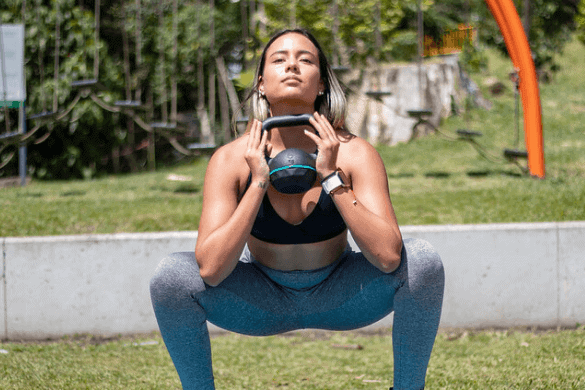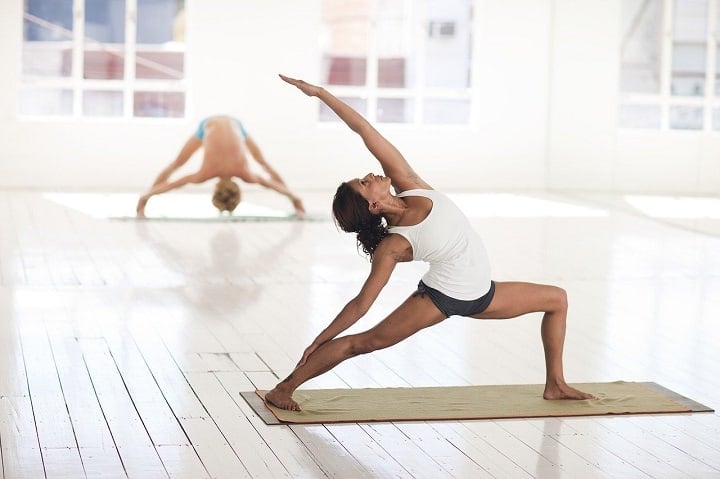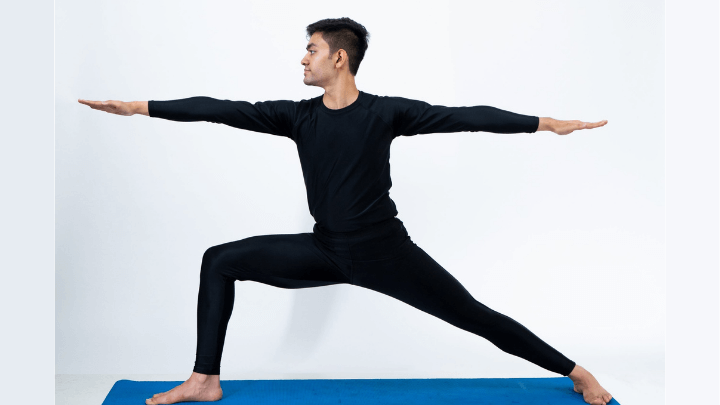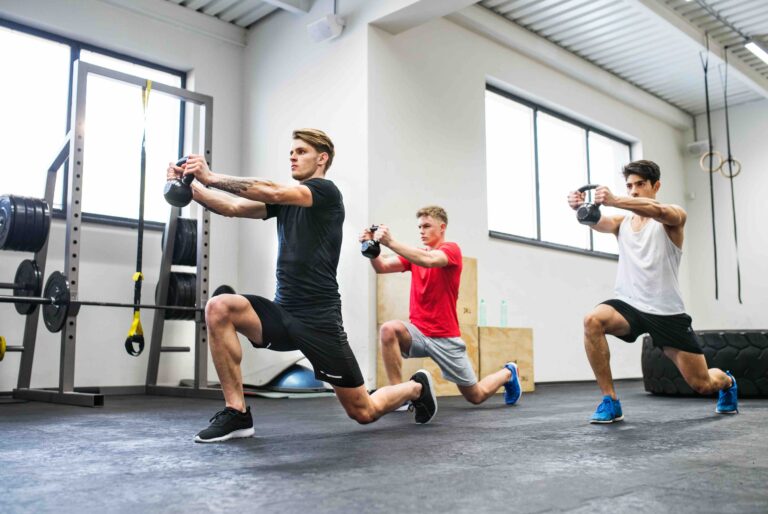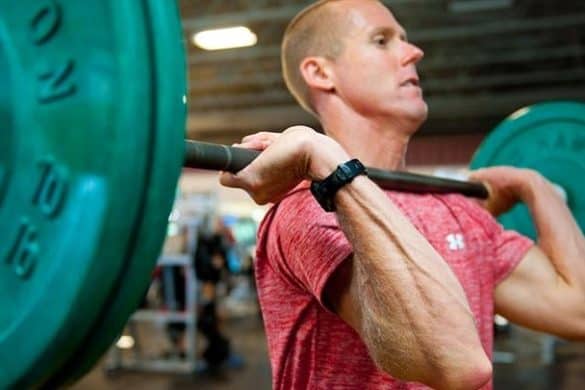This is a complete research-backed guide to why stretching is important.
First, I’ll show you why stretching is important including the seven scientific benefits.
Then, I’ll take you through the different types of stretching so that you can understand them.
Sound good? Let’s dive right in…
Contents:
- Key Points: Why Is Stretching Important?
- What are the different types of stretching?
- 7 Research-Backed Benefits Of Stretching:
- 1. Stretching makes you more flexible
- 2. Stretching increases range of motion
- 3. Increases blood flow to your muscles
- 4. Stretching decreases the chances of lower back pain
- 5. Stretching is great for stress relief
- 6. Stretching improves your posture
- 7. Stretching increases physical strength
Key Points: Why Is Stretching Important?

Stretching helps in many ways. Most importantly it improves flexibility, and as result, the range of motion of your joints.
Flexibility isn’t just beneficial for dancers and gymnasts, it can benefit you in a number of ways. It may:
- Improve your overall performance in many different kinds of physical activities
- Reduce the risk of any physical-exercise or sport injury
- Facilitate your joints moving through their full range of motion
- Help your muscles work more effectively
If that’s not enough, having a good stretch also increases blood flow to your muscles.
As long as you stretch properly at the right times, it’s likely it will be safe, although stretching should be applied with caution as epidemiological studies show that more research is needed [6, 7].
Introduction
When it comes to exercising and playing sports, there’s one thing that continues to be overlooked.
And this something is absolutely essential when it comes to preventing injuries.
This has nothing to do with equipment or having the right gear, it’s something much more simple – and that’s stretching.
Yes, stretching is beneficial in many aspects of your training or game.
Mobility and stability are two obvious ones, but studies also show that stretching is crucial in injury prevention. [1]
And as the research suggests, injury prevention is key to enhancing physical performance. [2]
Typically, when you think about stretching, it’s likely you’ll conjure up images of lithe gymnasts and flexible dancers contorting their bodies into weird and wonderful positions.
Their sheer flexibility and ability to adjust their bodies into seemingly complex positions leaves the rest of us mere mortals in awe.
But the truth is, stretching is very important for everybody – it doesn’t matter whether you’re doing recreational sports just for fun or you’re an Olympic athlete.
You’ll be surprised how much it will help with your personal day to day activities, let alone your sport, health, and fitness goals…
The Different Types Of Stretching

It’s important to understand the different types of stretching, when you should do them, and why.
Because, like many things, not all stretching exercises are created equal.
In fact, there’s not only one kind of stretch, there are over seven, which include:
1. Ballistic stretching
Uses the power of your moving body to try and force it beyond its standard range of motion.
Such stretches typically involve bouncing movements, such as repeatedly moving up and down to touch the toes.
This type of stretching is common among athletes like football players, basketball players, dancers, and martial artists, as the increased range of motion benefits performance, such as a martial artist kicking with more force or a basketball player jumping higher.
2. Dynamic stretching
Involves active movements where muscles and joints go through a full range of movement [3].
Typically used as part of a warmup, these stretches often mimic the same movements of a sport or activity you’re about to do.
Unlike ballistic stretches, these movements are slower, such as a forward lunge.
Dynamic stretching exercises are both functional and sport-specific movements.
They essentially help increase muscle temperature while decreasing your muscle stiffness, hence why they’re so important in preventing sports-related injuries.
3. Active stretching
Otherwise known as static-active stretching, this stretch requires you to hold a position without help using your agonist muscles [4].
An example of this is slowly lifting your leg high and holding it there without using anything else other than the leg muscles.
Again, this might be part of your warmup routine, as this type of stretching not only stimulates your muscles, but also prepares them for use throughout the exercise.
4. Passive (or relaxed) stretching
Is a relaxed stretch that requires you to hold your position for a set time using a partner or prop to intensify the stretch.
An example of such a stretch is the splits, where the floor acts as the “prop”.
Relaxed stretching is a great way to cool down after exercise, as it helps lessen post-workout muscle fatigue and pain.
An experimental study also discovered that passive stretching lowers glucose levels [5]
5. Static stretching
Is the use of a certain muscle or muscle group to stretch in one position, such as a butterfly stretch, for an extended period of time in a warmup routine for 20-40 seconds.
Static stretching may make you feel pain, but it’s that good kind of pain.
The main idea of this stretch is to push your muscles to a point in which you feel slight discomfort.
This is then held for a length of time – usually – 20 to 40 seconds.
6. Isometric stretching
Is a kind of static stretch that does not require motion and uses contraction-relaxation techniques, such as a calf stretch against the wall.
This stretch requires you to stretch and then hold it for approximately 7-15 seconds.
You then repeat the stretch a few times, ensuring you take a 20 second rest in between each stretch.
7. PNF stretching
Combines passive and isometric stretching, which is often performed with a partner, such as assisted leg raises and wide-open arm stretch.
PNF stretching should be done after you’ve exercised.
Do this at least twice a week to see and reap the rewards of range or motion while building muscle strength and boosting athletic performance.
7 Research-Backed Benefits Of Stretching
Here are seven research-backed reasons for how stretching before or after physical activity can benefit you.
1. Stretching Makes You More Flexible

According to multiple studies, stretching improve your flexibility which will help you in sport and everyday activities such as reaching for something out of a high cupboard. [8, 9, 10]
Developing more flexibility and general strength through stretching your body will help you withstand more physical stress.
Flexibility may also help get rid of any muscle imbalances in your body, and as a result your risk of injuring yourself is lowered [11].
Being more flexible also reduces that pain, because let’s face it, there’s no worse feeling than muscle cramps.
When you’re more flexible, your muscles ultimately become looser and less tense, and those aches and pains you may have once been accustomed to will disappear.
Stretching for muscular flexibility may also improve your posture [12].
While this may not be directly linked to sport, having proper alignment and correcting any muscle imbalances through stretching and strength training will help [13].
Summary: Stretching can make you more flexible and flexibility is essential for developing a good range of motion in your joints.
2. Stretching Increases Range Of Motion

As previously mentioned, flexibility from stretching improves your range of motion, which is basically how far you are able to move your joints in different directions.
Why is this important?
It’s simple – this is what will allow you to work out safely without risking pulling a muscle.
And when you’re able to get your muscles to fully extend, you’ll also unwittingly improve your strength and balance at the same time [14].
Not every joint is the same.
It is important to know they have different ranges of motions because of various natural aspects, such as the bones and soft tissue surrounding the joint that hold it together.
For example, the shoulder joint (a ball and socket joint) has the freest range of motion, allowing you to rotate your arm in a full circle in both directions.
On the other hand, the elbow joint (a hinge joint) has a range of motion that moves in one plane – up and down – similar to a door handle.
Summary: Range of motion (ROM) similar to flexibility, is the extent to which a joint can go through it’s established spectrum of movements.
What is important to remember is that different joints have different ranges of motions, and that the better ROM you have in a joint the easier that exercise will be because your body will be able to cope with the stress of a particular movement.
3. Increases Blood Flow To Your Muscles

Stretching also delivers oxygen-rich blood to the stretched muscles [15]. According to Alana Kessler, MS, RDN:
“Stretching improves circulation by gently pulling and tugging on the muscle and connective tissue, infusing them with conscious breath.
The combination of breathing with these actions helps to create fluid homeostasis in the body, supporting the health of the heart and kidneys.”
You’ll notice how beneficial stretching is to your health 15 minutes after a workout when your muscles are tired, warm, and mobile.
In this case, static stretching may help relieve tension in tight muscles.
This is not to say that you shouldn’t stretch prior to working out as well.
It doesn’t have to be anything fancy, but a simple 10-minute dynamic stretching routine combined with a 5-10 minute light cardio routine to increase your heart rate and ensure your muscles are mobile will again prevent injury.
Imagine your muscles as an old bicycle chain which keeps getting stuck and breaking because of the lack of upkeep and maintenance.
Now imagine oiling that very same chain – the oiling of the chain can be compared to your stretching. Your muscles are now oiled and ready to partake in whatever physical activity you’re about to do.
Summary: Stretching improves blood circulation to the stretched muscles and in turn helps support the health of the heart and kidneys.
It’s important to begin a workout with a 10 minute dynamic warmup to warm up the body before exercise.
Followed by a series of static stretches 15 minutes after your workout to help loosen tight muscles.
4. Stretching Decreases The Chances Of Lower Back Pain

There’s nothing worse than experiencing lower back pain – it can be excruciating.
In some cases, it can really put you out of action if you’re not careful.
Lower back pain is primarily caused by a weakness in the gluteus medius [16]…
However, studies also show that hip flexor muscles also play a role because they are attached to your pelvis which releases stress on the lumbar spine when short and tight [17].
Stretching your hip flexors when tight will help reduce the risk of suffering from lower back pain. But…
If your hip flexors are weak (Psoas and Ilicacus in particular) you could experience lower back pain, imbalances in the body, and improper exercise form.
The reason why you may experience a tight hip flexor could actually be because your hip muscles are weak as explained in the video below:
Summary: While lower back pain can be caused by several factors and muscle groups, the hip flexors have been shown to contribute to lower back pain if these muscles are weak and tight.
The solution is to stretch your hip flexors when tight and strengthen them when they are loose for greaterstability and a decreased risk of lower back pain..
5. Stretching Is Great For Stress Relief

There is a good reason as to why yoga is recommended for stress relief [18].
Yoga can be described as a mind-body practice which requires a combination of stretching, physical poses, regulated breathing, and meditative relaxation.
This form of stretching is a complementary and integrative health approach.
It combines physical (the stretching and poses) and mental disciplines (the breathing and meditation).
All of this will help you achieve a sense of peacefulness, not only for the body, but also the mind.
In short, stretching for stress relief helps you to relax properly while managing your stress and anxiety levels, which in today’s modern and hectic world is beneficial.
Additionally, when you are in pain, your mind will be focused on that problem which can make you:
- worried
- unable to focus
- negative
Stretching is an important way of giving your mind a mental break.
It can be a very relaxing process and due to the physical benefits such as a reduction in muscle tightness, your mind will feel at greater ease when muscles are relaxed and no longer in pain.
There is an important part of your brain called the cerebral cortex which processes the physical pain you experience and tells you “Ouch this really hurts”.
When you’re able to get rid of this feeling through meditative stretching, you can get on and enjoy your day without pain.
The lack of pain you begin to feel through such stretches and relaxation techniques may also help you sleep better at night [19].
Having no discomfort while you sleep will improve overall sleep quality and therefore improve other aspects of your overall health as well.
Elite athlete coach – Jeff Cavaliere MSPT, CSCS said:
“A static stretching routine will lengthen short muscles. It is important to stretch in the evening before bed because when you sleep, your body heals itself and when you wake up the next morning you should not only feel looser but you will likely have less muscle soreness as well.”
Summary: Physical pain is linked to mental stress [20, 21, 23].
It is important to remove the problem of pain in the body through stretching, to help your mind feel relaxed and free from stress.
6. Stretching improves your posture

With the rise of technology, the number of people doing manual labour jobs has dropped enormously.
What has replaced manual work?
Office jobs…
Today, many people spend a great deal of their time hunched over their computers.
The shoulders are slouched and the back is bent, which over time results in poor posture.
Studies show that we now sit for 9.5 hours a day – yes, you read correctly [24, 25].
And the thing is people have no awareness that they’re sitting incorrectly, so slowly but surely they’re weakening their muscles, damaging their bodies, and worsening their posture.
Four common areas of poor posture include:
- Neck
- Shoulders
- Mid-back
- Pelvis
However, it’s not just the aesthetics of poor posture you should be worried about.
Having a poor posture can have a knock-on effect on other aspects of your health from how your blood circulates to the way your body produces hormones [25, 26].
A poor posture will also impact your latter years and how you move later on in life as you age.
The above mentioned secondary health problems from having bad posture often don’t rear their ugly heads until it’s too late.
And, more often than not, people simply don’t realise that they could be impacting their bodies even with the obvious physical signs (rounded shoulders, anterior/posterior pelvic tilt, etc).
Thankfully, all is not lost and the power of stretching is far-reaching.
Stretching has been shown to be an important solution for fixing posture issues.
When you stretch the right muscles, you’ll open up and release tension where the muscles have become accustomed to years of poor posture.
Fixing your posture is a long-term commitment where you must be committed to changing with consistent weekly stretching [27].
In short, our bodies usually adapt to the different postures that we spend the majority of time in whether that’s at an office desk, a school desk, or curled up on the couch watching your favourite series.
Summary: Due to a large number of people sitting down, whether in front of a desk or driving, poor posture is a problem that lots of people do not think is bad for their body.
The solution is to stretch specific muscles consistently so that the poor posture will gradually improve over time.
Once the muscle has loosened after multiple stretching routines, it’s also important to strengthen weak muscles which are not supporting the posture problem.
7. Stretching increases physical strength

Stretching has said to be a “light” type of exercise, and therefore it can’t improve your strength and muscle definition.
This could not be further from the truth [28]
Flexibility and range of motion have already been previously highlighted.
But what has this got to do with strength training and building muscle definition you ask?
Quite a lot.
When you stretch different parts of your body, you’re essentially lengthening your muscle tissues, which increases your flexibility.
These things improve strength by allowing you to perform different strength-building movements with a wider range of movement, and as a result, your exercise becomes more effective – it’s a win-win!
Also, when you’re working on building muscles through weight and bodyweight exercises, tiny tears in the muscles appear, causing lactic acid to build up [29].
And when you stretch your body properly post-workout, you help it to circulate fresh blood while feeding all the essential nutrients into your hungry muscles, which in turn help grow and tone them [30].
Conclusion
It’s no secret that to lead a healthy lifestyle you need to be active and do more exercise.
Perhaps you do cardio workouts each week, such as running, aerobics or playing football.
Or perhaps you’re more into lifting and building strength.
Whatever type of exercise or physical activity you do, you simply can’t afford to overlook stretching.
Stretching your body’s muscles is absolutely crucial for a number of reasons, but the most important one is – stretching prevents injury.
Because if you get injured, you make everything worse and you won’t be able to exercise at all.
Now I’d like to hear from you:
What tip from this guide have you learnt?
Are you aware that posture can be improved with stretching?
Or maybe you found out that there are multiple types of stretching?
Either way, let me know by leaving a comment.


